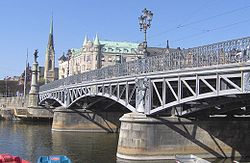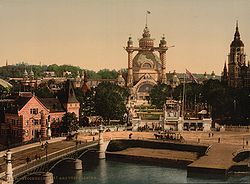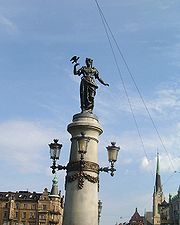
Djurgårdsbron
Encyclopedia

Bridge
A bridge is a structure built to span physical obstacles such as a body of water, valley, or road, for the purpose of providing passage over the obstacle...
in central Stockholm
Stockholm
Stockholm is the capital and the largest city of Sweden and constitutes the most populated urban area in Scandinavia. Stockholm is the most populous city in Sweden, with a population of 851,155 in the municipality , 1.37 million in the urban area , and around 2.1 million in the metropolitan area...
, Sweden
Sweden
Sweden , officially the Kingdom of Sweden , is a Nordic country on the Scandinavian Peninsula in Northern Europe. Sweden borders with Norway and Finland and is connected to Denmark by a bridge-tunnel across the Öresund....
. Designed by Carl Fraenell and built for the Stockholm World's Fair 1897
General Art and Industrial Exposition of Stockholm (1897)
The General Art and Industrial Exposition of Stockholm of 1897 also known as Stockholm Exhibition or Stockholm World's Fair was a World's Fair staged in 1897 in Stockholm, Sweden....
, the present bridge forms a southern extension to the boulevard Narvavägen, thus connecting mainland Östermalm to the island Djurgården. It is one of four bridges stretching from Djurgården, the others being Djurgårdsbrunnsbron
Djurgårdsbrunnsbron
Djurgårdsbrunnsbron is a bridge in central Stockholm, Sweden, connecting northern and southern Djurgården. It is the city's only remaining swing bridge, the default bridge type in Stockholm during the 19th century...
, Beckholmsbron
Beckholmsbron
Beckholmsbron is a wooden bridge in central Stockholm, Sweden, connecting the two islands Djurgården and Beckholmen.Originally built in 1848-1858 when the first docks were constructed on Beckholmen, Beckholmsbron is the only remaining wooden bridge in Stockholm still used by heavy vehicles...
, and Lilla Sjötullsbron
Lilla Sjötullsbron
Lilla Sjötullsbron is a concrete pedestrian bridge in central Stockholm, Sweden. Passing over Djurgårdsbrunnskanalen it connects Djurgården island to the mainland north of it....
.
Featured on the bridge standing on tall granite
Granite
Granite is a common and widely occurring type of intrusive, felsic, igneous rock. Granite usually has a medium- to coarse-grained texture. Occasionally some individual crystals are larger than the groundmass, in which case the texture is known as porphyritic. A granitic rock with a porphyritic...
column
Column
A column or pillar in architecture and structural engineering is a vertical structural element that transmits, through compression, the weight of the structure above to other structural elements below. For the purpose of wind or earthquake engineering, columns may be designed to resist lateral forces...
s are four Old Norse
Norse mythology
Norse mythology, a subset of Germanic mythology, is the overall term for the myths, legends and beliefs about supernatural beings of Norse pagans. It flourished prior to the Christianization of Scandinavia, during the Early Middle Ages, and passed into Nordic folklore, with some aspects surviving...
gods, sculpted by Rold Adlersparre: Heimdall
Heimdall
In Norse mythology, Heimdallr is a god who possesses the resounding horn Gjallarhorn, owns the golden-maned horse Gulltoppr, has gold teeth, and is the son of Nine Mothers...
blowing in his Gjallarhorn
Gjallarhorn
In Norse mythology, Gjallarhorn is a horn associated with the god Heimdallr and the wise being Mímir...
; Odin
Odin
Odin is a major god in Norse mythology and the ruler of Asgard. Homologous with the Anglo-Saxon "Wōden" and the Old High German "Wotan", the name is descended from Proto-Germanic "*Wodanaz" or "*Wōđanaz"....
's wife Frigg
Frigg
Frigg is a major goddess in Norse paganism, a subset of Germanic paganism. She is said to be the wife of Odin, and is the "foremost among the goddesses" and the queen of Asgard. Frigg appears primarily in Norse mythological stories as a wife and a mother. She is also described as having the power...
holding a rod; Freyja with a falcon
Falcon
A falcon is any species of raptor in the genus Falco. The genus contains 37 species, widely distributed throughout Europe, Asia, and North America....
(one of her guises) in her hand; and Thor
Thor
In Norse mythology, Thor is a hammer-wielding god associated with thunder, lightning, storms, oak trees, strength, the protection of mankind, and also hallowing, healing, and fertility...
with his hammer Mjolnir resting on his shoulder. Flanking the pathways are cast iron
Cast iron
Cast iron is derived from pig iron, and while it usually refers to gray iron, it also identifies a large group of ferrous alloys which solidify with a eutectic. The color of a fractured surface can be used to identify an alloy. White cast iron is named after its white surface when fractured, due...
railings displaying stylized plants and the abutment
Abutment
An abutment is, generally, the point where two structures or objects meet. This word comes from the verb abut, which means adjoin or having common boundary. An abutment is an engineering term that describes a structure located at the ends of a bridge, where the bridge slab adjoins the approaching...
s and candelabra
Candelabra
"Candelabra" is the traditional term for a set of multiple decorative candlesticks, each of which often holds a candle on each of multiple arms or branches connected to a column or pedestal...
s designed by the architect Erik Josephson (1864–1929).
History


Appearing together with the original bridge on a map dated 1733, a new bridge built in 1730 by King Frederick I
Frederick I of Sweden
Frederick I, , was a prince consort of Sweden from 1718 to 1720, and a King of Sweden from 1720 until his death and also Landgrave of Hesse-Kassel from 1730...
(1676–1751) requiring a roadworthy passage to the Royal hunting grounds, was referred to as Fredrikshovsbron ("The Court of Frederick Bridge") due to its vicinity to the palace Fredrikshov. Concerned for the state of the bridge, the king six years later had the bridge leased out to the island's surveyor, who, made responsible for its maintenance, was authorized to take up bridge tolls fixed by the king. The bridge gave way, non the less, under the king's coach in 1745.
The bridge is mentioned again in 1801, then referred to as Djurgårdsflottbro ("The Djurgården Pontoon Bridge
Pontoon bridge
A pontoon bridge or floating bridge is a bridge that floats on water and in which barge- or boat-like pontoons support the bridge deck and its dynamic loads. While pontoon bridges are usually temporary structures, some are used for long periods of time...
"), said to allow the passing of ships, and having a ramp crossing a marshy terrain and therefore partly resting on logs. This bridge, in 1820 described as decayed, rotten, and grass-grown, was replaced by another wooden bridge in 1825 on the order of King Charles XIV John
Charles XIV John of Sweden
Charles XIV & III John, also Carl John, Swedish and Norwegian: Karl Johan was King of Sweden and King of Norway from 1818 until his death...
(1763–1844). Sadly, a stone bridge discussed at this time was never carried out, and by 1849 the new bridge was in such a state it had to be replaced by a three-span iron bridge resting on wooden poles. To ensure the loading ratio before its inauguration, 200 men from the guard regiment nearby were order to march back and forth across the bridge in different formations, an odd practice considering the insignificant number of people being able to swim at the time.
Reinforced in 1886, the iron bridge was demolished in 1895 to be replaced by the current three-span steel bridge, 18 metres wide, about 58 metres long, and able to carry the new tram
Tram
A tram is a passenger rail vehicle which runs on tracks along public urban streets and also sometimes on separate rights of way. It may also run between cities and/or towns , and/or partially grade separated even in the cities...
s. The provisional bridge used during the construction was pulled down following the World's Fair
General Art and Industrial Exposition of Stockholm (1897)
The General Art and Industrial Exposition of Stockholm of 1897 also known as Stockholm Exhibition or Stockholm World's Fair was a World's Fair staged in 1897 in Stockholm, Sweden....
in 1897. Because of post-WW2 traffic loads, the bridge had to be reconstructed in 1977, a job done in three months - the three spans wielded on the quay and lifted in place using a pontoon crane.
External links
- Stockholmskällan - historical images of Djurgårdsbron.

